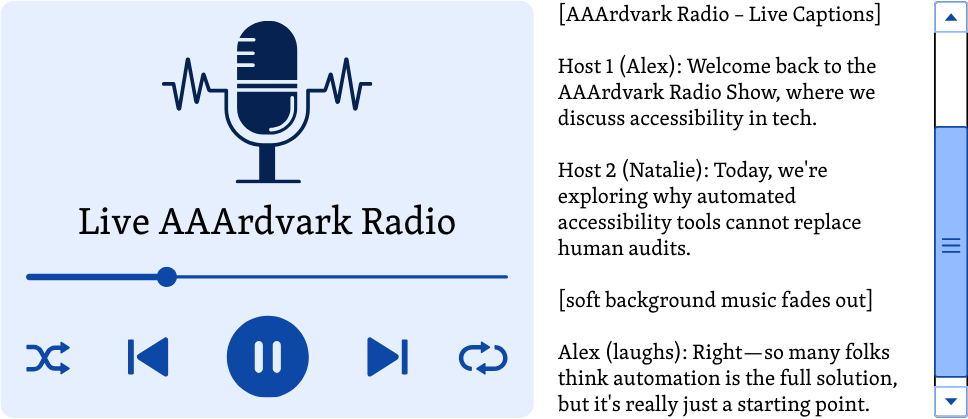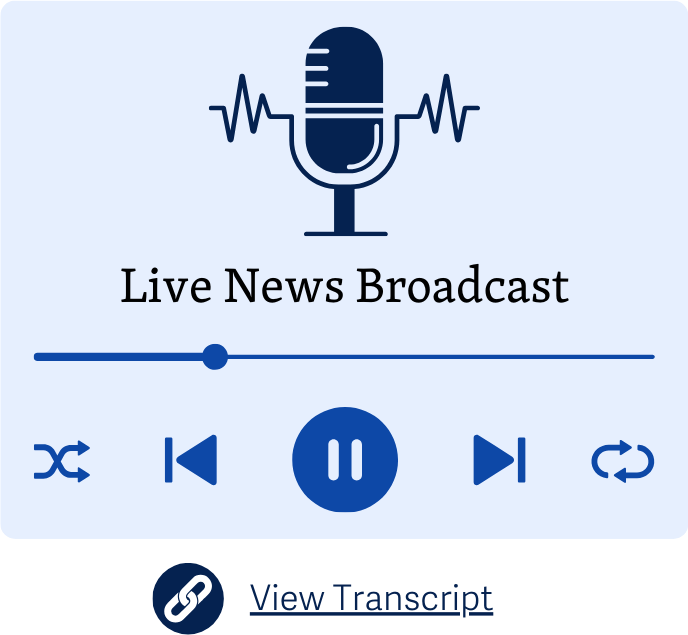1.2.9 Audio-only (Live)
Live captioning is provided for live audio.
What is it?
If you're sharing live audio content online—like a live podcast, radio stream, or an audio-only webinar—you'll need to provide a text version so people who can't hear it can still follow along.
This could be live captions typed in real time or a transcript if the audio is scripted. The text should cover all the important spoken information, and any meaningful sounds too, such as [music playing] or [applause].
The goal is simple: make sure people who can't hear the audio aren't left out.
Quick comparison: Though they're similar, WCAG 1.2.4 Captions (Live)(AA) applies to live video with audio (like livestreams or newscasts). 1.2.9 focuses on live audio-only content, like a radio broadcast or audio-only event, and requires a text version so users can still access the information.
Why does it matter?
If there's no text option, people who are deaf or hard of hearing are completely left out of live audio content. They can't hear what's being said, and without captions or a transcript, they have no way to access that information.
Even people with auditory processing issues might struggle to follow spoken words in real-time. Being able to read along can make a huge difference, especially during fast-paced or complex conversations.
Think about a breaking news audio stream or a live podcast. If you can't hear and there's no text, you're missing everything. That's what this guideline helps prevent.
Who is affected?
People who are d/Deaf or hard of hearing. People with auditory processing disorders.
People who are d/Deaf or hard of hearing rely on text alternatives to access audio content. Without captions or transcripts, they're excluded from live events like speeches, radio shows, or press briefings.
People with auditory processing challenges may find it difficult to make sense of spoken words, especially when the speaker talks fast, there's background noise, or multiple voices are involved. Reading a real-time caption or transcript helps them stay in the loop.
How to implement 1.2.9
This section offers a simplified explanation and examples to help you get started. For complete guidance, always refer to the official WCAG documentation.
Live Captioning Services
The most flexible and accurate option is to use real-time captioning, also called CART (Communication Access Realtime Translation).
A trained professional listens to the live audio and types what’s being said using special equipment. Captions appear with just a slight delay and often include non-verbal details like [laughter], [music playing], or [audience claps].
This approach is perfect for unscripted content like interviews, Q&As, live commentary, or breaking news.
Integrating Captions
There are a few ways to make live captions accessible on your site:
- Display them in a separate section near the audio player (like a sidebar or panel).
- Some platforms let you embed captions right into the player, so they show up alongside the live stream.

Transcripts
If your audio follows a strict script, like a prepared press statement, a speech, or a theatrical reading, you can use a prepared transcript instead.
Just make sure it closely matches what’s actually being said. If the speaker goes off-script or there's unexpected content, a transcript won't be enough on its own.
Also, be sure to:
- Place a clear, visible link near the audio stream labeled something like “View Transcript”
- Make it easy to find. Don't make users hunt around the page

Conclusion
Adding a text equivalent for live audio-only content makes your content more inclusive and accessible. Whether it’s real-time captions or a well-matched prepared transcript, this helps ensure that people who can't hear and people who need extra support to process audio can still fully engage in live experiences. Everyone deserves to know what's being said in the moment.

